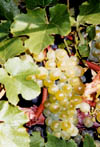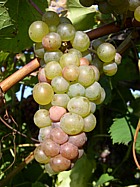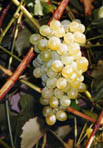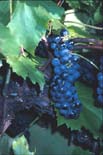French-American and Other Interspecific
Varieties
The introduction of the North American pests, phylloxera (Daktulosphaira
vitifoliae) and powdery mildew (Uncinula necator), into Europe in
the mid-1800's was devastating to grape growing enterprises. French hybridizers
responded by developing new varieties using wild American species resistant
to phylloxera, powdery mildew or other diseases. Breeders rushed to the market
with the results of their crosses in an effort to solve the crisis. These selections
were usually identified with the name of the originator plus a number; many
were later named.
The first products of these programs (developed by breeders
and nurserymen such as Seibel, Couderc, Kuhlmann and Bertille Seyve) were widely
planted in Europe, but wine quality was disappointing when compared with the
traditional varieties. Additional time was required to hybridize and select
improved types. Also, initial crosses utilized low quality V. vinifera
grapes, such as Aramon, as parents. Aramon is grown widely in Europe, but only
for bulk, not quality, wine production. Later products of French breeding programs
descended from vinifera parents known for high quality wines. These more
recent hybrids, such as Vidal blanc and Vignoles, have received more acclaim
for their wine quality.
In the development of the French-American hybrids, the use of
V. labrusca was avoided so as not to impart its strong flavor to the
new selections. Many other wild American species were used, especially V.
aestivalis lincecumii (the Post Oak Grape), V. rupestris (the
Sand Grape) and V. riparia (the Riverbank Grape). The flavors of the
French-American group are quite variable but much more subtle than the flavors
of many varieties derived from V. labrusca.
More recent introductions from North American breeding programs
have been based upon further crosses using French American hybrids, native American
species and V. vinifera varieties. It was only coincidental that
some of the varieties bred in France were adapted to conditions in New York.
Varieties produced by North American breeding programs are selected specifically
for their adaptation to local conditions.
Several interspecific varieties are sensitive to attack by soil
borne virus diseases of the ringspot complex. These varieties include Cascade,
Baco noir, De Chaunac, Ventura and Vidal blanc. Grafting these varieties onto
virus resistant rootstocks is advisable for this reason.
Ripening seasons for wine varieties are listed in Table
3.
Interspecific Varieties
for Red Wine Production
|
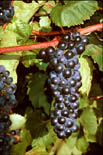
Cascade
|
Cascade
(Seibel 13053) is a productive and moderately hardy variety. The medium
to large loose clusters ripen early. Bird damage is often a problem. Wines
are generally light in color and body with low acidity. Because of its susceptibility
to soil borne virus diseases and generally low wine quality, acreage has
declined dramatically since 1975 (Table
1). |
|
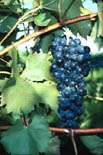
Chambourcin
|
Chambourcin
(Joannes-Seyve 26-205) is a late ripening grape which may produce a highly
rated red wine when fruit fully matures. It requires a long growing season
and a site less subject to low winter temperatures. The large, moderately
loose bunches set medium sized blue berries. The vine is very productive
and cluster thinning is required. |
|
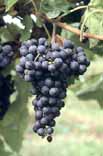
Chancellor
|
Chancellor
(Seibel 7053) was once widely planted in France for table wine production.
It is moderately cold hardy and productive, but requires cluster thinning.
In terms of wine quality, Chancellor is among the better French-American
varieties. Planting might be more widespread if the clusters were less
susceptible to downy mildew and the foliage less susceptible to powdery
mildew.
|
|
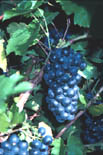
Chelois
|
Chelois (Seibel 10878) wine quality ranks highly among the French-American hybrids. It has, however, experienced a major decline in acreage in New York as demand for red wine decreased during the 1980's. There has been a resurgence of interest in Chelois in the early 1990's as consumer interest in red wine again increased. Chelois is suitable for blending with other red hybrids (Chambourcin, Baco noir and Chancellor) or V. vinifera varieties. Vines are healthy, vigorous and productive, but require cluster thinning to prevent overcropping. Berry splitting and subsequent bunch rots may be severe in some years. Because of susceptibility to winter damage, Chelois should be planted on better sites. Small blue-black berries are borne on compact, medium-sized clusters. |
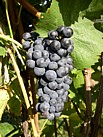
Colobel
|
Colobel (Seibel 8357) produces a heavily pigmented juice useful for blending as a coloring agent. Wine quality by itself is poor. Vines are very productive but just slightly cold hardy. The large clusters of blue-black berries ripen late. |
|
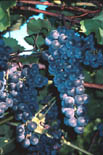
De Chaunac
|
De
Chaunac (Seibel 9549) is a very productive and vigorous variety. Cluster
thinning is required to maintain yield and fruit quality. The clusters
are large and loose, resulting in few problems with bunch rots at harvest.
Wine is only fair in quality and the vine is subject to soil borne virus
problems. Because of shrinking demand, acreage has declined dramatically
in recent years.
|
|
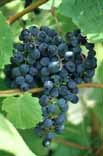
|
Frontenac is a recently released red wine grape (Landot 4511 x V. riparia) from the University of Minnesota, 1996. The vine is extremely vigorous, productive, and cold hardy. Foliage and fruit are highly resistant to downy mildew, and the fruit are resistant to Botrytis bunch rot. High sugar levels along with high acidity are typical at harvest. The acidity usually requires some adjustment during the wine-making process. Wines have been characterized by some tasters as having deep color with elderberry, cherry, and perfumy notes. Other tasters have found it to be too vinous and candy-like. More information on Frontenac
Frontenac Gris is a grey-fruited sport of Frontenac used to make white wines. The vine has essentially the same vineyard characteristics as Frontenac. However, the wine is quite different, said to have peach, apricot, pineapple and citrus aromas, with no herbaceous or labrusca character. This variety has not been tested at the Geneva Experiment Station. |
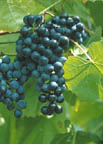 |
GR 7 - ("Geneva Red 7") - (Buffalo x Baco noir) highly vigorous, highly productive and winter hardy, with moderate resistance to diseases. 'GR 7' makes dark red wines with a classical hybrid aroma. It has better tannin structure than Baco noir and De Chaunac. It still has a short finish. It is best made as a light (not heavily extracted) wine. Use hot pressing, short skin contact time or some carbonic maceration. It has a place in traditional red hybrid blended wines, and is already in limited commercial production. Predicted temperature of 50% primary bud kill in mid winter = -17.1 F * |
| Léon
Millot (Kuhlmann 194-2) is an early ripening black grape produced from
the same cross as Maréchal Foch. The wines are
similar, with distinct berry aromas. Vines tend to be similar as well, although
Léon Millot tends to be more vigorous and productive. |
|
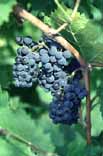
Maréchal Foch
|
Maréchal
Foch (Kuhlmann 188-2) is a very early ripening black grape with small
berries and clusters that produce a fruity light red table wine. The vines
are hardy and medium in vigor and production. Maréchal Foch should
be grafted on a resistant rootstock to ensure adequate vigor. Birds are
attracted to the small black berries. |
|
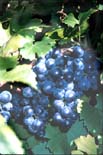
|
Rougeon
(Seibel 5898) is hardy and very productive but sometimes exhibits a biennial
pattern of bearing. The wine is of high color and is used primarily
for blending. |
|
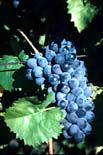
|
Villard
noir (Seyve-Villard 18-315) is a late ripening, productive variety which,
on favorable sites, produces good quality red wine. For best performance,
choose a site with moderate winter temperatures and a long growing season.
Grafted vines are recommended to improve vigor, especially on heavy soils.
Cluster thinning is also necessary to prevent overcropping. |
|
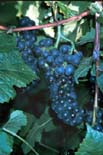
|
Vincent
was released in 1967 by the Horticultural Research Institute of Ontario
(HRIO) at Vineland, Canada. The vine is medium in vigor, very productive
and ripens late. This dark blue grape produces a very dark juice that is
useful for blending with varieties with low pigment content. Care must be
taken to control powdery mildew. |
|
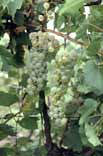
Aurore
|
Aurore
(Seibel 5279) is the most widely planted non-labrusca grape in New York.
Processors have used Aurore to extend the harvest season since the fruit
matures in late August and early September, before most other varieties
are ripe. The vine is productive and vigorous, and produces large bunches
of amber colored berries. Bird damage and fruit rot are often a problem.
Wine quality is poor and it is being replaced by interspecific varieties
of higher quality. The major use has been for bulk wine production, frequently
blended with V. labrusca varieties.
|
|
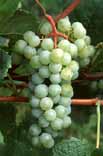
Cayuga White
|
Cayuga White,
named at Geneva in 1972, is one of the most productive and disease resistant
varieties grown in New York. Its wine has been highly rated, having medium
body, and good balance. An important positive attribute is its versatility;
it lends itself to making semi-sweet wines emphasizing the fruity aromas,
and is also made as a dry, less fruity wine with oak aging. When harvested
early, it may produce a very attractive sparkling wine with good acidity,
good structure, and pleasant aromas. When over-ripe, however, it can develop
strong hybrid aromas with slight American overtones. The excellent cultural
characteristics and high wine quality indicate an important future for
this variety in New York.
|
|
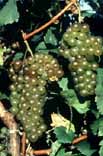
Chardonel
|
Chardonel
(Plant patent 7860) was named by Cornell University in 1990 due to superior
performance in Michigan and Arkansas. Cold hardiness has been nearly as
good as for Seyval in New York, but good locations with long growing seasons
are required to fully ripen the fruit. This cross of Seyval
x Chardonnay produces an excellent wine when fully ripened, with fruit
aromas characteristic of Chardonnay and Seyval. The potential for sparkling
wine production appears to be good.
View release bulletin
|
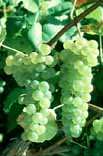
Horizon
|
Horizon,
named at Geneva, NY in 1982, is suitable for production of bulk white wine.
The low acidity makes it useful in blending. Wines have been described as
a neutral and free of labrusca and hybrid flavors, but in some recent samples,
labrusca and hybrid aromas have been noted by some taste panelists.
The vine is very productive and winter hardy, however Botrytis bunch
rot is a problem in some years. |
|
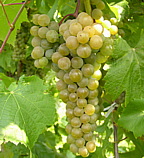
La Crescent
|
La
Crescent is a recent introduction (2002) from the University of
Minnesota, formerly known as MN1166. Noted for its excellent winter hardiness
and suitability to northern climates, it is usually harvested at mid-season.
The white wine has a distinct apricot, citrus and pineapple aromas, and
is also suitable for blending. Yields are moderate. |
|

Melody
|
Melody (Plant
patent 6159) was introduced by Cornell University in 1985. The young wine
is fruity with hints of apricot and floral aromas. Quality is among the
better of the white hybrids. The vine is moderately disease resistant (Table
2) and very productive and vigorous. Selection of well exposed canes
when pruning will ensure an adequate crop each year. No cluster thinning
is required. Melody is in limited commercial production and acreage is increasing. |
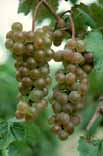
Ravat 34 |
Ravat 34
is a selection of the French hybridizer, J.F. Ravat. It is early ripening,
moderately vigorous, productive and winter hardy. Wine quality is good.
There is limited commercial experience with this variety in New York. Yield
trial results from Fredonia, New York indicate excellent potential. |
|
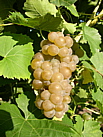
Seyval
|
Seyval (Seyve-Villard
5-276, commonly marketed as Seyval blanc) is one of the most widely planted
hybrid grapes east of the Rocky Mountains. When harvested at optimal maturity,
its wines have attractive grassy, hay, and melon aromas. The body tends
to be thin, and malolactic fermentation and barrel fermentation/oak aging
are used to enhance quality. The vine tends to overbear and must be thinned
to ensure proper ripening and to maintain vine size. Grafting is also recommended
on all but the most fertile sites. Fruit clusters are very susceptible to
Botrytis bunch rot. |
|
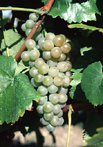
Traminette
|
Traminette was named and
released at Geneva in 1996. This Gewürztraminer hybrid produces wines
of excellent quality similar in aroma to its well-known parent. There
is good balance in the must between levels of sugar, acid, and pH. The
vine is much more winter hardy than its Gewürztraminer parent, moderately
productive, and just slightly susceptible to powdery mildew and Botrytis.
Maturity is late mid-season, Oct. 5-10 in Geneva. Flavor expression with Traminette is best when the must
is given some (24 to 48 hours) skin contact with 50 mg/L SO2 at 5 C. Wines
made with skin contact do not develop objectionable bitterness or high
pH, though this should always be monitored. If necessary, pH should be
adjusted before fermentation (should be no higher than 3.4). In fruit
grown in warmer regions increased bitterness and a high pH must might
become a problem. Then shorter skin contact time should be used. If very
long skin contact times are used, the typical floral / spicy Gewürztraminer
flavors may shift to muscat-like flavors. Typically, the wines made with some skin contact have
strong spice and floral aromas, a full structure, and long aftertaste.
The wine can be made dry or sweet. Mouthfeel of the dry wine is good with
nice texture and good spice feel.
View release bulletin |












